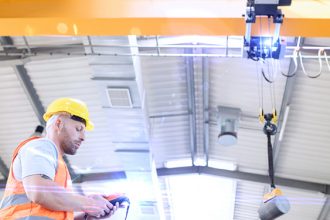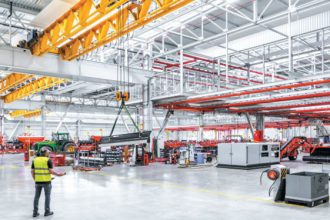
Hoist end users often ask if the hoists produced by the members of the Hoist Manufacturers Institute (HMI) are suitable for lifting guided loads or for lifting, lowering, or supporting personnel. Many hoist users assume that if the equipment’s capacity is sufficient to provide a very high margin of safety, these applications are acceptable.
“However, that is not the case,” said Bob Burkey. Burkey is a senior engineering advisor for MHI member Columbus McKinnon Corp. He is also a member of the HMI technical committee.
“As part of its work, HMI periodically highlights unsafe practices in the field with a goal of awareness and change in practices,” added Robert Beightol. He’s director of marketing for MHI member Gorbel Inc. and HMI’s president. “Using material handling hoists for guided loads and utilizing hoists for the transport of personnel can be unsafe for a variety of reasons.”

Regulatory Requirements Covering Hoists and Guided Loads
 First, there are regulatory requirements to consider, Burkey said. HMI member companies produce hoists for material handling applications that meet OSHA and ASME B30.16 Safety Standard requirements. OSHA cites the ASME B30 Standards that includes the ASME B30.16 Safety Standard for Overhead, Underhung and Stationary Hoists. It states that hoists designed and built to this standard are suitable for vertical lifting and lowering of freely suspended, unguided loads that consist of equipment and materials.
First, there are regulatory requirements to consider, Burkey said. HMI member companies produce hoists for material handling applications that meet OSHA and ASME B30.16 Safety Standard requirements. OSHA cites the ASME B30 Standards that includes the ASME B30.16 Safety Standard for Overhead, Underhung and Stationary Hoists. It states that hoists designed and built to this standard are suitable for vertical lifting and lowering of freely suspended, unguided loads that consist of equipment and materials.
“This standard does not cover hoists designed and built for lifting a guided load or personnel,” Burkey said. “Therefore, using hoists designed and built to comply with the ASME B30.16 standard for lifting guided loads or personnel is a violation of OSHA regulations.”
Examples of guided loads are elevators, doors, dam gates, and platforms. However, if a restraint is used to prevent the load from centering itself under the hoist when lifted, it should be considered a guided load, he observed. Guided loads have the potential of dragging or jamming in the upward or downward direction.
“If the load drags or jams going up, it will result in an overload of the hoist and supporting structure. That could result in a failure and a dropped load,” Burkey explained. “If the load drags or jams going down, it will result in the hoist continuing in the downward direction and paying out slack rope or chain between the hoist and the load.”
Then, if the load releases, it will fall against the slack rope or chain, impacting the hoist and supporting structure. The outcome could be a failure and a dropped load, he said.
“Hoists built to the ASME B30.16 Safety Standard do not have the features required to function properly in these applications,” continued Burkey. “Therefore, they should never be used in these applications.”
Hazards Associated with Elevators and Platforms
 Elevators and platforms are another type of guided load. These present additional hazards beyond the upward or downward jamming risks inherent in a guided load application, added Burkey.
Elevators and platforms are another type of guided load. These present additional hazards beyond the upward or downward jamming risks inherent in a guided load application, added Burkey.
First, elevators and platforms have a very high potential of transporting or supporting personnel even when this was not their intended use. Therefore lifting, lowering or supporting an elevator or platform with a hoist designed to meet the ASME B30.16 Safety Standard violates OSHA regulations. It also violates the ASME B30.16 Safety Standard, which prohibits lifting, lowering or supporting personnel with these hoists.
Second, a suspended elevator or platform can be loaded at elevated positions where the hoist is supporting the load, Burkey said. Many material handling hoists also feature an overload device. This prevents the lifting of too heavy a load that might damage the hoist and supporting structure.
“However, in the case of an elevator or platform in an elevated position, if a load is placed on the elevator or platform that exceeds the trigger point of the overload device, the device could release, dropping the elevator or platform,” he said. “This scenario is another example of why an operation should never use a hoist designed for material handling to lift, lower, or support an elevator or platform.”
The Right Hoist Essential for Lifting People
For personnel handling applications, the design requirements for hoists designed for lifting, lowering, or supporting personnel are very specific. Hoists designed and built to the ASME B30.16 Safety Standard do not meet these requirements, Burkey added. Therefore, HMI member companies’ hoist products designed and manufactured to the ASME B30.16 Safety Standard should never be used in these applications.
“There is equipment available for use in these applications. HMI recommends that end users consult qualified individuals who have experience with these applications. They can specify equipment that is suitable,” he noted.
“In some cases, hoist manufacturers may offer equipment designed for these applications. These solutions go beyond the design and build requirements for material handling hoists specified by OSHA and ASME,” Burkey continued. “These hoists have special features not found in a typical material handling hoist that make them suitable for these applications.”

Learn More About Safe Use of Hoists
For HMI members, emphasizing safe work practices involving the use of hoists is always top‑of‑mind.
“HMI makes safe working practices a consistent priority. We provide materials such as fact sheets and tip cards to OSHA. HMI also offers content examining dos and don’ts of hoist use at the user level,” said Beightol.
Further, HMI develops user seminars as part of the MHI Overhead Alliance. This group combines the extensive reach of organizations in the hoist, crane and monorail sectors, Beightol noted.
To learn more about HMI, visit mhi.org/hmi.



